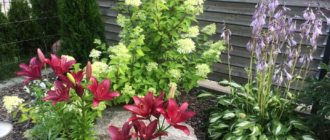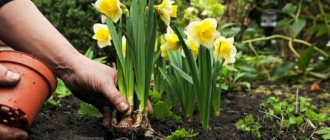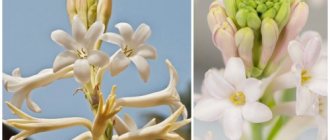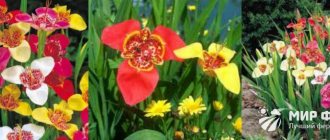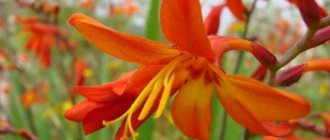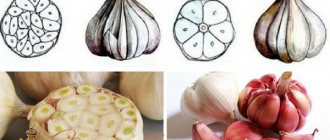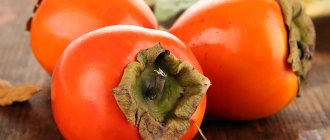Many summer residents strive to grow hyacinths on their property, planting and caring for them in the open ground requires a certain amount of time. In this article we will look at how to grow these beautiful flowers (even in those regions where the ground freezes in winter), when to dig up hyacinths, how to store the bulbs, and how to propagate the variety you like.
Hyacinths in a flowerbed (photo by Nadezhda Abramovich, Krasnodar)
In early spring, as soon as the snow melts, green arrows of hyacinths sprout from the ground. This flower with a charming and pronounced aroma comes in all shades of the rainbow. The tassel-shaped inflorescences can be either regular or double in structure; there are usually 20-30 buds on the peduncle.
Brief description of cultivation
- Landing . Hyacinth bulbs are planted in the fall in September or October. And they are dug up every year after the foliage turns yellow (in the last days of June or early July).
- Storage . For storage, the bulbs are placed in a well-ventilated area with moderate humidity. They are placed in paper bags or in 2 layers in boxes. For the first two months, planting material is stored at a temperature of about 25 degrees, and then it is transferred to a cooler place (about 17 degrees).
- Illumination . Needs plenty of bright sunlight.
- Soil . It should be nutritious, drain well and contain a large amount of humus. Acidity should not be lower than 6.5.
- Watering . During prolonged drought, hyacinths should be watered so that the soil is wet to a depth of 15 to 20 centimeters.
- Fertilizer . You need to feed the flower twice or three times during the season. The first feeding is at the very beginning of the growing season with phosphorus-nitrogen fertilizer, the second is during the formation of buds and the third is when the bush fades with phosphorus-potassium fertilizer.
- Reproduction . Seeds and babies.
- Harmful insects . Flower flies (hoverflies), aphids, thrips, onion root mites, stem and root-knot nematodes and mole crickets.
- Diseases . Penicillium rot, rhizoctonia blight, fusarium blight, yellow or soft bacterial rot, variegation.
- Properties . Any part of the plant contains a poisonous alkaloid.
Storing hyacinth bulbs
Storing dug up bulbs is the most critical period. It is at this time that the process of inflorescence formation occurs in the bulb. Its different stages require different temperatures in a certain duration and sequence. Dug up hyacinths are more demanding of heat than tulips or daffodils.
Immediately after digging, the hyacinth bulbs are dried for 5-7 days at 20°C in a dark, ventilated room, cleaned of soil and root debris, then sorted by size and placed in boxes in no more than 2 layers. Small children are not separated.
If there are only a few bulbs, it is convenient to store them in paper bags with labels. Further storage of large flowering hyacinth bulbs is recommended to be carried out in 2 stages: the first - at elevated temperatures, the second - pre-planting.
At the first stage, hyacinth bulbs are kept for at least 2 months at 25..26°C, and at the second stage - 1 month at 17°C. The air humidity in the room should not be too low, otherwise the bulbs will dry out. If you want to shorten the first stage by a week, then in the first week of the first stage, raise the temperature to 30°C (the room should be well ventilated).
Hyacinth (Hyacinthus).
It is easy to calculate that the total duration of the preparatory period is at least 95 days. Plus, before planting, it is useful to keep hyacinth bulbs in a cold room at temperatures close to outside. So it turns out that in order to plant the bulbs in the ground in the first ten days of October, you need to dig them up later than the beginning of July. Late digging and storage of bulbs at too low temperatures are the main reasons for further poor flowering of hyacinths.
Often during storage, hyacinth bulbs form numerous small babies around the bottom. They break off easily, and therefore bulbs with children should be planted in the ground especially carefully. In this case, the planting depth must be halved and the planted bulbs must be covered with a layer of mulch, increasing it compared to conventional cover. Such children grow up to be 4-5 years old. It is very simple to cause their formation: immediately after digging, firmly wipe the bottom of the bulb with a dry cloth, removing the roots.
Features of hyacinth
Hyacinth is one of the earliest spring flowers. This plant is native to North Africa, the Middle East and the Mediterranean. However, Holland has done a lot to popularize hyacinth, which is why many people call it the world’s “hyacinth center.” The largest number of varieties and varieties of hyacinth appeared in the Netherlands. And from the city of Haarlem, which is located in Holland, a huge number of bulbs of this flower are sent all over the world every year.
In hyacinths, the dense bulb consists of lower succulent leaf plates. The height of the flowering stem is about 0.3 meters; it is a continuation of the bottom. In a faded bush, the stem dries out along with the narrow leaf plates directed upward, which sit at the very bottom of the stem. However, in the corner of the upper leaf plate on the stem inside the bulb, a bud is formed, which over time becomes a new bulb, which will bloom next year. Bulbs can also form in the corners of other leaf blades, but they are weaker. These bulbs are children; if necessary, they can be separated and new bushes grown from them. The flowers are part of the apical racemes, which have a cone-shaped or cylindrical shape. The flower's perianth has the shape of a bell-shaped funnel, its blades are bent, and the color is rich. The inflorescences can be painted in various color shades, for example: red, purple, yellowish, white, pink, blue, etc. The flowers can be double or simple. This plant has a three-lobed fruit, with each nest containing a pair of seeds covered with a delicate peel.
All about HYACINTHES: proper planting of hyacinths, care and feeding. Subtleties of forcing hyacinths
Botanical description
Hyacinths are one of the earliest spring flowers. The homeland of hyacinths is the Middle East, North Africa and the Mediterranean, but Holland has done so much to popularize them that it can rightfully be called the world’s “hyacinth center.” The largest number of varieties and varieties of hyacinths were created in the Netherlands, and every year millions of hyacinth bulbs are sent around the world from the Dutch city of Haarlem.
Dense hyacinth bulbs consist of succulent lower leaves, and the flowering stem (30 cm in height), which is a continuation of the bottom, dries out after flowering along with narrow, upward-directed leaves, sitting at the very bottom of the stem, but in the corner of the upper leaf, on the stem inside The bulb forms a bud, which gradually turns into a bulb that will bloom next year. In the corners of other leaves, weak bulbs, so-called children, are often also formed, which can be separated and used for vegetative propagation. Hyacinth flowers are collected in apical racemes in the shape of a cylinder or cone. The perianth of the flower is a brightly colored bell-shaped funnel with bent blades.
- Centaury: cultivation, properties, types
The hyacinth color shades represent a wide palette: white, red, pink, lilac, blue, pale yellow... According to the shape of the flowers, hyacinths are simple and double. The hyacinth fruit is three-lobed, each nest contains two seeds with a delicate peel.
See photos of hyacinth with the names of the species and variety here
Features of cultivation
Each crop has its own agrotechnical requirements. Hyacinth differs from many flowers in that it is quite capricious and demanding to care for. That is why, before decorating your garden with it, you need to find out how to properly care for it and what it needs for normal growth and development. Basic rules for growing hyacinth:
- The soil must be neutral; it should contain turf and leaf soil (1:1), as well as baking powder. If the soil is acidic, then lime will have to be added to it, and clayey soil can be corrected by adding sand to it.
- This plant reacts extremely negatively to stagnation of water in the soil, which is why it should be provided with good drainage.
- Choose a sunny place to grow hyacinth, but excessively bright lighting can harm it.
- A site that is located close to trees and shrubs is well suited for planting, because the flowers must be protected from gusts of wind.
- Do not feed hyacinths with fresh organic fertilizer.
Preparing bulbs - what should planting material look like?
It is known that you need to purchase bulbous heads from a trusted store. When choosing planting material, carefully inspect it and make sure that it is not damaged or infected with disease. Elastic, smooth skin indicates that the bulb is healthy. Its diameter can be 4–6 cm, this is a quite good indicator of volume. Advice! If you are purchasing an adult specimen, inspect the stem and leaves. They should stand straight, facing up. The peduncle should be in the same position.
If seedlings are purchased long before planting time, they are provided with “autumn” conditions. Place them in the basement or on the bottom shelf of the refrigerator. Wrap the bulb in the ground with plastic wrap and ventilate the storage area.
Planting hyacinths in open ground
What time to plant
Hyacinth bulbs are planted in open soil in the last days of September or the first days of October. If you plant them ahead of schedule, then they may begin to grow, and the coming winter cold will destroy them. If they are planted later than necessary, then they may not have time to take root well before frost.
The area where hyacinths will grow must be prepared in advance. Digging the soil to a depth of 0.3 to 0.4 m, add 10 to 15 kilograms of rotted compost or three to four year old humus, as well as approximately 15 grams of magnesium sulfate, 70 grams of superphosphate and 30 grams of potassium sulfate from calculation per 1 square meter. Depending on what the soil consists of, you can also add peat or sand to it if necessary. If the soil on the site is sandy, then 1.5 times more potassium and magnesium fertilizers should be added to it. It is recommended to feed hyacinths with nitrogen-containing fertilizers in the spring and summer.
Planting in autumn
It was already mentioned above that hyacinth bulbs are planted in the garden in the autumn, or more precisely, in September–October. Experienced gardeners advise planting medium-sized bulbs, which are also called “flower bulbs,” because they produce flower stalks that are highly resistant to bad weather.
First, inspect the planting material and remove all diseased, soft or injured bulbs. Then, before planting in the soil, they are immersed in a solution of a fungicidal preparation for 30 minutes. The bulbs, reaching approximately 50 mm in diameter, are planted to a depth from the bottom of 15 to 18 centimeters, the row spacing should be about 20 centimeters, and the distance between the bulbs should be 15 centimeters. Smaller bulbs, as well as children, are planted at a shallower depth, and the distance between them also needs to be reduced.
Hyacinth grows best in open soil if it is planted in a “sandy jacket”. To do this, a layer of clean river sand is poured onto the bottom of the groove or planting hole, the thickness of which should be about 30–50 mm. Press the onion a little into this layer and sprinkle it on top with sand and only then with soil. Thanks to this planting method, there will be no stagnation of water in the soil, as a result of which the risk of rot on the bulb will be significantly reduced. If the bulbs are planted in dry soil, they must be watered.
Planting hyacinths in a new way
Spring planting
Hyacinth bulbs are not planted in spring.
How to properly replant garden hyacinths
Garden hyacinths, like indoor hyacinths, are very depleted during flowering. Transplantation helps maintain the bulb in good condition and stimulate the formation of a high-quality flower bud. In addition, “relocation” to a new site serves as a kind of prevention of diseases that can be caused by bacteria accumulated in the soil.
You need to transplant garden hyacinth to a new place in the garden after flowering has ended and the leaves have dried out. For most regions of Russia, the work period falls on the end of September - beginning of October.
Changing the site too early, as well as too late, will negatively affect the condition of the bulb. In the first case, high temperatures will provoke rapid growth of the leaf mass, as a result of which the flower will die after the first frost. In the second, the plant simply does not have time to take root and adapt to new conditions.
Before planting in a new place, the bulbs must be carefully removed from the garden bed, all soil removed and dried. For prevention, you can treat the planting material with a weak solution of potassium permanganate or a fungicide.
Site selection and soil preparation
The ideal bed for garden hyacinths is a well-lit area without drafts. Neighborhood with trees and bushes is undesirable, since their root system takes all the nutrients from the ground.
A site on a small hill where water will not accumulate during rains and melting snow is suitable. Hyacinths react negatively to prolonged stagnation of moisture, they can get sick and even die.
For successful cultivation, you should pay attention to the quality of the soil in the new location. It should be quite loose with an acidity of 6.5 units. The following points are also important:
- Do not fertilize the soil with fresh chicken droppings or mullein;
- You can reduce the acidity of the soil by adding lime flour to it;
- You need to dig the ground to a depth of 1 spade bayonet;
- The preparation of the site must be carried out in advance, in the month of August, the deadline is a few weeks before planting.
Before planting, be sure to add the following components to the soil:
- Rotted compost or humus (up to 15 kg);
- Dolomite flour and wood ash (2 and 1.5 cups, respectively);
- Coarse river sand mixed with peat.
Transplantation scheme
The transplant is carried out in several stages:
- Small holes with a diameter of 15-18 cm are dug in the prepared area.
- The distance between the holes should be 10-20 cm depending on the size of the bulb.
- Sand is poured into the bottom of the hole, onto which the bulb is placed, bottom down.
- You need to deepen the bottom of large planting material by about 15 cm, small bulbs sit higher.
- The hyacinth is covered with soil, watered a little and covered with a layer of mulch (fallen leaves, sawdust, peat).
To prevent hyacinth bulbs from freezing in winter, it is recommended to additionally mulch them with the onset of cold weather. You can remove the shelter in the spring, when the air temperature reaches approximately +15 degrees.
Hyacinth care
Caring for hyacinth grown in open ground is not too difficult, but you need to know all the agrotechnical rules of the crop and be sure to follow them. First of all, you need to ensure that there are no weeds in the area where the hyacinth grows, so weeding should be regular and timely. You should also remember that the surface of the soil around the bushes must be systematically loosened and this is done quite often. In order to reduce the number of watering, weeding and loosening after planting the bulbs in the ground, its surface is covered with a layer of mulch. Hyacinth should be watered only during drought, and the soil must be wet to a depth of 15–20 centimeters.
Fertilizer
In order for such flowers to grow and develop well, they must be fed in a timely manner. During the growing season, you only need to feed the bushes 2 or 3 times. Flowers can be fed with dry fertilizer, applied to the soil, or with a liquid nutrient solution (in this case, slightly less fertilizer is used). Before adding a nutrient solution to the soil, the flowers must be watered. If dry fertilizers are used, then they are scattered over the surface of the site, and then embedded in the ground using a hoe. Feeding time:
- the first - at the very beginning of the growing season, 20 to 25 grams of saltpeter and 15-20 grams of superphosphate per 1 square meter are used for fertilizing;
- the second - during the formation of buds, for this purpose 30 to 35 grams of superphosphate and 15–20 grams of potassium sulfate are added to the soil per 1 square meter;
- third - after the bushes have flowered, 30–35 grams of potassium sulfate and the same amount of superphosphates per 1 square meter are used.
Transfer
In order to transplant hyacinths to another area, it does not require much effort. To begin with, in the summer, when the bushes have faded, dig up the bulbs and put them away for storage. And with the onset of autumn, plant them in a new area. The bulbs are dug up a couple of months after the hyacinths have faded. This time is necessary so that the bulbs have time to regain strength after the growing season and flowering.
How to plant hyacinths in the garden in spring
Despite the fact that hyacinth is considered to be a primrose, its beautiful blooms can be admired later. To do this, bulbs are planted in open ground in the spring. If this season is chosen for planting, then before starting the process, it is recommended to place the flower bulbs in the refrigerator for an hour, or rather, in the freezer. Gardeners call this method of planting stratification. Thus, deceptive conditions for simulating “winter cold” are created. The main thing is to do everything wisely, do not freeze the bulb for too long, otherwise it will freeze and you may not wait for flowering. Common sense and weather forecasters with meteorological forecasts will tell you when to plant hyacinths in open ground in the spring. The soil must be warmed by the spring sun's rays, and the threat of frost is also unacceptable.
Ammonium nitrate and potassium will serve as soil fertilizers during spring planting. Of course, they should be used on the ground after the snow has completely melted.
To allow the roots of the plant to breathe, it is recommended to loosen the soil from time to time after spring planting with garden tools.
When the beautiful hyacinth has bloomed, its bulb will again require attention and care. During this period, the soil will again need to be treated with superphosphate and potassium sulfate. The faded flower itself can be cut off higher, allowing the plant to fade naturally. It is not recommended to leave the bulbs in the same place every year; the soil and the flower should rest from each other for 3 years. The thing is that the soil can accumulate pests and various pathogens, and the handsome bulbous plant is quite sensitive to them.
All articles about hyacinths on the site can be read by following this link...
Over the course of a year, each planted bulb produces 3-4 shoots, so propagating beautiful spring primroses is not difficult! With proper care, the bulb will delight you with flowering and aroma again and again.
Propagation of hyacinths
Growing from seeds
Hyacinth can be propagated by seed, which is ideal for those involved in plant breeding. Sowing of seeds is carried out in the last days of September, for this they use a box filled with a substrate consisting of humus, leaf soil and sand (2: 1: 1). Seedlings are grown for two years in a cold greenhouse. Hyacinths that emerge from seeds very rarely retain the varietal characteristics of the mother plant, which is why gardeners prefer to propagate such a plant vegetatively.
Reproduction by children
It is much easier to propagate hyacinth by children than by seeds. But at the same time, you need to take into account that the children on the bulbs grow extremely slowly, so in 1 year from 1 to 3 children can be formed. Try to separate the babies from the parent bulb; if they come off without much effort, then they are planted in a separate hole and grown. However, if the children are separated with great difficulty, then they are left on the parent bulb, which is planted in the ground with them.
In industrial floriculture, hyacinths are propagated by artificial methods, namely by cutting and cutting out the bottom. To do this, take a very sharp instrument and sterilize it well, make cuts on the bottom with it, or cut it out completely. Next, the bulbs are stored in a special way, and they form babies. It happens that about 40 children are formed on one bulb. This method of propagating hyacinths is described in great detail in the book “Plant Reproduction” by F. MacMillan Brose.
Propagation of hyacinth, cutting out the bottom, varietal hyacinths
Is it possible to replant a blooming hyacinth: how to replant a blooming hyacinth after purchase?
For what reason might you suddenly need to replant a blooming hyacinth without waiting for the plant to bloom, I don’t know. Experienced flower growers know that only faded hyacinths can be replanted. But you can still carefully transfer a flower from one container to another using the transfer method - when the plant, carefully without damaging the roots, is transferred from a small to a larger pot. It is worth considering the risk that if during transfer the hyacinth is accidentally damaged, the plant will quickly drop its flowers after such a procedure and the leaves will turn yellow.
But there is another way to prolong the life of hyacinth for a long time, by replanting annually without “torture methods”.
After flowering has completed, the peduncle shoot should be cut off, leaving a green shoot 1–2 cm high above the dove of the bulb. You can transplant the plant into a larger pot if this has not been done previously. In this case, drainage must be poured onto the bottom. Take store-bought soil or add peat and sand to regular soil. Replant the bulb without deepening it too much, and place the pot in a warm, well-lit room.
Caring for the plant during this period consists of moderate watering and fertilizing with complex mineral fertilizers. Also, after the formation of leaves, the hyacinth can be moved to open ground. Transplantation is carried out in the spring, after the completion of frosts and has its own characteristics; more about them below.
Diseases and pests of hyacinths
Diseases
Hyacinths are quite resistant to diseases. However, if they were affected by the disease, then this could happen for the following reasons:
- the purchased planting material was already affected by the disease;
- the flowers were fed with fresh organic fertilizer;
- bad predecessors;
- a spoiled onion was planted in the ground;
- before planting, the bulbs were not subjected to preventive treatment;
- planting too thick.
Most often, this plant is affected by bacterial rot (bacterial disease), because of which the bulbs become like mucus, which smells very bad. The first signs of rot are that the bush is stunted in growth, and stripes and spots form on its foliage and peduncles. Diseased flowers are removed from the soil and destroyed, and the place where they grew is treated with bleach.
Hyacinth can also be affected by penicillium rot (a fungal disease). All parts of the affected bush located above the ground are covered with plaque, which is a product of sporulation of the fungus, rot appears on the plant, and its flowers dry out. To save the plant, it should be treated with a product containing copper.
Harmful insects
Various pests can also greatly harm hyacinth. The greatest danger to it is posed by flower flies; their larvae gnaw out the bottom of the bulbs. In order to get rid of them, they use such means as: Tabazol, Fly eater or Aktara. The flower can also be damaged by the mole cricket, which eats its underground part, as well as the root onion mite; the best way to combat such pests is by mulching the soil surface around the bushes.
It happens that the inflorescence just appears from the rosette and almost immediately falls out of it. This can happen due to stagnation of water in the ground, due to storing the bulbs in too cold a place, or due to early planting.
How to preserve a hyacinth bulb after forcing
Growing hyacinths at home gives excellent results. In a room they can bloom from January to May, as they are kept in more favorable conditions than their garden counterparts. Knowing how to transplant hyacinth, you can get a wonderful specimen for your home collection.
This species is characterized by a pronounced period of rest, which occurs after flowering. At this time, the aboveground part of the plants dies. The same process is observed in “gift” copies. Experts recommend transferring them to cultivation in open ground after growing them at home.
The next flowering of forced hyacinths will occur no earlier than in two years, even under the most favorable conditions.
Garden hyacinths are removed from the soil for dry storage until autumn. Indoor specimens are treated differently. Their bulbs are not able to safely survive two months outside the ground. The most painless option: transplant the bulbs. In this case, they will be safely preserved until autumn, when it is time to plant them in open ground. Transplanting indoor bulbs has a number of nuances that you need to know and follow.
Care after flowering
After the hyacinths fade, their bulbs begin to regain their strength. Therefore, they must remain in the soil for some time. As soon as the bushes begin to fade, all care should be reduced to a gradual reduction in watering until it stops completely. In addition, do not forget to fertilize the soil for the third and last time at this time; thanks to it, the bulbs will receive the necessary amount of nutrients, which will have a beneficial effect on the growth and flowering of hyacinths in the next season. You can tell that the time has come to remove the bulbs from the ground by the foliage, which should turn yellow.
Digging up the bulbs
It is necessary to remove the bulbs from the soil every year. Otherwise, next season the bushes will bloom sparingly, and the likelihood that the bulbs will be affected by disease also increases. Also, thanks to the digging of hyacinths, which is carried out every year, it is possible to promptly discard spoiled bulbs and regularly separate the children.
Try to dig up the bushes before their foliage dies and falls off, as in this case it is very difficult to find the exact location of the bulbs. To remove the bushes from the ground, use a shovel, since the bulbs are located quite deep. The extracted bulbs will need to be washed under running water and pickled for half an hour in a Karbofos solution (3–4%), instead they can be left for 10 minutes. soak in very warm water (about 50 degrees). After this, they are placed in a shaded, well-ventilated place to dry for 7 days, the air temperature should be about 20 degrees.
How to preserve hyacinth after flowering
Storing hyacinth bulbs
At this time, you need to take care of the bulbs with all responsibility, since it is now that the inflorescence will form in them. After the bulbs are dried, they need to remove any remaining scales and roots. After which they are sorted and placed in boxes (preferably in 1 layer). It is better to leave too small children on the bulbs. If there are few bulbs, then to store them you can use paper bags with a signed label attached to them.
During storage of hyacinths, there are 2 stages. During the first two months, the bulbs should be kept at a temperature of 25 to 26 degrees, and then they are removed to a cooler place (about 17 degrees). The air should not be too dry, as this may cause the bulbs to dry out. In order to shorten the first stage of storage by 7 days, in the first week the planting material should be stored at a temperature of about 30 degrees. Do not forget that you need to choose a well-ventilated room for storing hyacinths. And immediately before planting the bulbs in the ground in the fall, it is recommended to keep them for about 7 days at the temperature that is typical for the garden. As a rule, during storage a large number of small children are formed on the bulbs; therefore, they must be planted in the soil very carefully.
How do hyacinths reproduce?
Hyacinths reproduce in open ground in various ways. All of them take a sufficient amount of time, but are not very labor-intensive.
- Cutting out the bottom;
- Notching the bottom;
- Scales from bulbs;
- Leaf cuttings.
Growing a new corm takes up to 3 years. However, from one corm you can get a large number of hyacinth babies, suitable for planting in open ground in the spring.
Cutting the bottom
The procedure is not complicated, just follow the algorithm:
- Remove the basal lamina from the bulb by cutting it with a curved scalpel.
- Then remove the shoot embryo and bud, exposing the part of the tuber that produces new bulbs.
- Treat the cut side with a fungicide to prevent disease and rot as new bulbs grow.
- Place the cut onion upside down in a dark, warm place for several weeks until the cut heals.
- You should wait until the new babies have grown their own roots before removing them from the mother bulb.
Notching the bottom
The technology for cutting the bottom is the same as the cutting algorithm, but it is simpler and faster. Instead of completely separating the bottom, propagation is carried out using cuts with a depth of 1/3, 1/4 of the depth of the bulb. If you keep them in a dry place, new bulbs will form at the cut sites. Over the course of 2 years, the sprouts will gradually transform into full-fledged tubers. Next in the spring, hyacinths are planted.
Scales from bulbs
Before separating the scales, it is necessary to prepare a nutrient substrate. Choose a light and nutritious mixture. Store-bought soil enriched with minerals will do. The procedure looks like this:
- Pour soil into the bag
- Moisten the soil. The humidity should not be excessive; it is enough to spray the peat with a spray bottle.
- Separate the scales from the bulb. Up to a third of future babies can be detached without harm to the mother tuber.
- Place the scales in peat.
- Place in a box and place in a dark, well-ventilated, warm place.
New corms form within two months. They will have their own root system, which indicates their readiness for replanting and further growth next year. In spring, you can plant young hyacinths in a pot.
Leaf cuttings
During the flowering period, it is necessary to cut off several strong, dense leaves. The leaves are placed in a greenhouse, where prepared soil is poured: a layer of peat, on top - a layer of sand of 2 - 3 cm. Future seedlings are kept moist for several weeks. The formation of a child can be monitored by observing the condition of the seedling. A yellowed and dead leaf means that the formation of a new corm has been successful, and soon the hyacinth can be planted in the ground.
Types and varieties of hyacinths with photos and names
Hyacinth has been cultivated both in open ground and indoors for about 400 years. And not so long ago, experts believed that there were about 30 species and approximately 500 varieties of hyacinths. However, when the reorganization of classifications in botany occurred, most species were transferred to another genus. Today there are only 3 types of hyacinths, namely: eastern hyacinth (Hyacinthus orientalis), Litvinov hyacinth (Hyacinthus litwinowii) and Transcaspian hyacinth (Hyacinthus transcaspicus). Thanks to the efforts of breeders, many varieties and varieties have been obtained from these species.
All varieties are divided according to the shape of the flower - double and simple, according to the timing of flowering - late, early and middle, and also according to the color of the flowers. In the classification of flower color, all varieties are divided into 6 groups.
Blue hyacinths
- Perle Brillante . This is a late-flowering variety, the flowers have a pale blue hue, the height of the bush is about 25 centimeters, the flowering duration is about 20 days.
- Marie . An early flowering variety, flowering lasts from 16 to 18 days. The flowers are dark blue in color and decorated with a longitudinal purple stripe.
- Queen of the Blues . The flowering of this medium variety lasts approximately 15 days, the height of the bush is about 30 centimeters. The bluish flowers have a faint odor.
Lilac hyacinths
- Blue Magic . The height of the bush of this medium variety is about 25 centimeters, flowering lasts from 10 to 12 days. The color of the flowers is violet-purple.
- Indigo King . This late-flowering variety blooms for about 15 days, the length of the arrow is from 15 to 17 centimeters. The flowers are glossy purple-black.
- Bismarck . The flowering of this early-flowering variety lasts about half a month; the bush reaches a height of 22 to 25 centimeters. Light purple flowers are decorated with a longitudinal stripe of a more saturated shade.
Pink hyacinths
- Moreno . The early-flowering variety blooms for 13–18 days, the peduncle reaches a length of 20 to 23 centimeters. The color of the flowers is raspberry pink, they have a stripe of a darker shade.
- Anna Marie This medium variety has a long arrow - from 20 to 25 centimeters, and its flowering lasts approximately 15-17 days. The flowers are painted in a soft pink shade.
- Gertrude . The flowering period of this late-flowering variety lasts from 13 to 15 days, and its peduncle reaches a height of 23–25 centimeters. The flowers are dark pink.
Red hyacinths
- Hollyhock . This late-flowering variety blooms for 15–18 days, its peduncle has a height of 20–22 centimeters. Double flowers have a crimson-red color.
- La Victoire . The height of the peduncle of this early-blooming variety is from 20 to 25 centimeters, and glossy pinkish-red flowers open on it. Flowering duration is from 11 to 12 days.
- Tubcrgen's Scarlet . The flowering of this average variety lasts a little longer than half a month. The height of the peduncle is about 20–22 centimeters, the flowers are deep red and can be double.
White hyacinths
- Arentine Arendsen . The height of the bush of this early-flowering variety reaches 21–22 centimeters; it blooms from 15 to 18 days. The flowers are white or may have a cream tint.
- Snow Crystal . This late-blooming hyacinth has white, double flowers. Flowering duration is 13–18 days, and stem length is 25–28 centimeters.
- Madame Sophie . The flowering of this medium variety lasts 13–15 days, its stem length is from 19 to 23 centimeters. Double flowers are white.
Yellow and orange hyacinths
- Yellow Hammer . The arrow of this medium variety reaches 23–25 centimeters in length, and it blooms for 13 to 15 days. The flowers, painted in a rich yellow color, fade towards the end of flowering.
- City of Haarlem . The late-flowering variety has a flowering duration of 15 to 17 days, the length of the peduncle is from 25 to 27 centimeters. The yellowish flowers become pale cream at the end of flowering.
- Orange Boven . The flowering of this medium variety lasts about half a month. On peduncles 22–24 centimeters long there are apricot-salmon flowers, the edges of which are dark pink.
Most often, blue varieties begin to bloom first, and then white, pink, red, and lilac. And orange and yellow varieties bloom later than everyone else.
hyacinths 30 varieties
Replanting after purchase into a new pot
Hyacinths are valued for their large inflorescences of bright, rich colors. To maintain the decorative appeal of flowers, proper care and replanting are necessary. Houseplants need to change location more often. Their space is limited by the walls of the pot, so the overgrown roots and emerging children become cramped. But garden plants also vitally need this procedure.
Hyacinths often end up in an apartment as a blooming holiday gift. At the same time, some bulbs are practically devoid of soil. Flower lovers who don't want to throw away hyacinth are wondering whether it is necessary to worry about it after purchasing it? It is better not to disturb the plants during flowering; this rule is known even to novice gardeners. But without soil, the bulb will not be able to accumulate nutrients and will not last until autumn transplantation into open ground. If you do everything carefully and correctly, then there is a chance to preserve hyacinth at home.
What you will need for transplantation:
- ceramic or plastic pot with a diameter of 10 cm and a height of 15 cm;
- material for drainage - expanded clay, clay shards, gravel;
- universal soil for flowers or a mixture of turf, leaf soil and sand;
- clean, settled water.
Advice. When replanting hyacinths, wear protective gloves; the plant bulb contains toxic substances.
The first step is to prepare a new pot. A drainage layer up to 5 cm high is poured onto the bottom. It will ensure rapid drainage of excess moisture through the holes in the bottom of the container. Sprinkle sand on top of the expanded clay. Now it's time to remove the bulb from the pot along with the earthen ball. It can be easily removed, but try not to damage the overgrown roots. The flower is placed in the center of the prepared container, the free space around the roots is filled with soil. You cannot completely bury the bulb like in a garden plot; it should be 1/2 peeking out of the ground. Water the plant, being careful not to get it on the bulb.
Advice. While the flower is taking root in a new place, protect it from direct sunlight.
After purchase, replanting into another pot is done only as a last resort. If possible, you should wait until the end of flowering and the complete drying of the ground part. In some cases, flower growers do not wait for autumn and plant hyacinth in open ground as early as May. This gives the bulbs a chance to take root and begin accumulating nutrients.
